
HYBRID HUES - COLOURS INTRODUCED FROM WILD CATS
Hybridizing domestic cats with wild cats has introduced some new variations on the basic range of colours and patterns. As the hybrid breeds have progressed, new colours have either been introduced through outcrossing, or have appeared spontaneously through new gene interactions. An "introgression event" is the incorporation of alleles from one species into the gene pool of a different species through hybridisation and backcrossing. For example, the Bengal was derived from crossing Asian Leopard Cats (ALC) with domestic cats. Many of the domestic cats used in Bengal breed foundation were random-bred or feral cats, and may have contributed domestic cat genes unique to the Bengal breed and selectively bred for, and that are not present (or were selectively bred out) in pedigree breeds.
Let's begin with the Bengal ....
When the Bengal was first developed, breeders decided to concentrate on the colours closest to those of the Asian Leopard Cat. Although blue and tortoiseshell cats had cropped up in early breeding, these were not perpetuated as breeders did not want to create "just another tabby cat". The domestic cats used early on in Bengal breed development had included, or carried the recessive gene for, colourpoints and which led to the first of the Snow Bengals: Seal Lynx Point. In the 1980s, Burmese outcrosses were used to introduce Seal Sepia and, when the 2 genes met up, Seal Mink. These attractive colour variants were accepted. "Whited" Bengals referred to white underparts, akin to the wild cat and is highly desirable in the Toyger, a tiger-striped derivative of the Bengal.
"Ocelli" are the white spots on the backs of the ears. These are desirable, but rarely if ever found after the F3 generation.
The accepted patterns are Spotted and Marble, but there are variations on both of these. Breeders have a number of descriptive terms for the different types of spot: arrowhead, donut etc, and they should be horizontally aligned or randomly placed. The sought-after Rosette pattern is a form of spotting pattern where the spots are clustered together (often with a deeper version of the background colour in the centre). The best rosetted patterns came from a line that had incorporated a margay hybrid from the failed Bristol breeding programme.

A true marble pattern has horizontally flowing markings which may be hollow with a deeper version of the base colour in the centre (clouding). Interaction with domestic cat pattern genes produced a number of variations on the marbled them. The horizontal flowing marble pattern is the sought-after pattern. It's a horizontally aligned marble that bears little resemblance to the classic tabby of domestics. The reduced horizontal flowing marble pattern simply has fewer dark markings, but is horizontally aligned. The Chaos pattern is sought-after as it is a random hotch-potch of marble and rosette patterns. There is also the undesirable "bull's eye" marble pattern that is essentially a classic tabby where the dark markings have ragged edges and some paler areas. Add denser, larger markings and you get the "closed" or "sheeted" marble pattern which is essentially a heavily marked pattern with a sheet or cape along the back; the markings have ragged edges and little background colour is visible between them. This pattern tends to open up as the cat reaches maturity. At the other extreme, Bengals with "reduced patterns" have more background colour showing.
The original accepted colours of the Bengal were:
Brown - this ranges from golden-brown through various shades of tawny to a reddish-brown backgroun. Brown Bengals have black or deep brown markings. Chocolate entered the gene pool from domestic cats and it produces brown, rather than black markings, but in some colour combinations this is difficult to identify. Because the silver gene is present in the breed, it's very likely that the recessive "golden" form of this gene is also present and accounts for golden-toned Brown Bengals with a "floating" pattern.
Silver - the background is silvery or almost white and the markings are black. These appeared in the 1990s and the silvery background colour was an attractive contrast with the exotic patterns. Instead of bright golden rufousing, they had silver frosting. While they may not have been on the agenda originally, their attractive appearance won over the cat fancy.
Snow - this includes Seal Lynx (Tabby) Point, Seal Mink and Seal Sepia and derives from cats used early in the breeding programme. Seal lynx point Bengals are blue-eyed and have buff, tan or grey markings on a pale cream background. Seal Minks are cream or buff with brown markings.
Seal Sepia have a deeper ground colour and dark brown markings.
According to breeder lore "recessives are forever," hence there are a number of emerging colours not currently recognised, but nevertheless attractive, such as charcoal, sorrel, wheaten and "whited" colours.
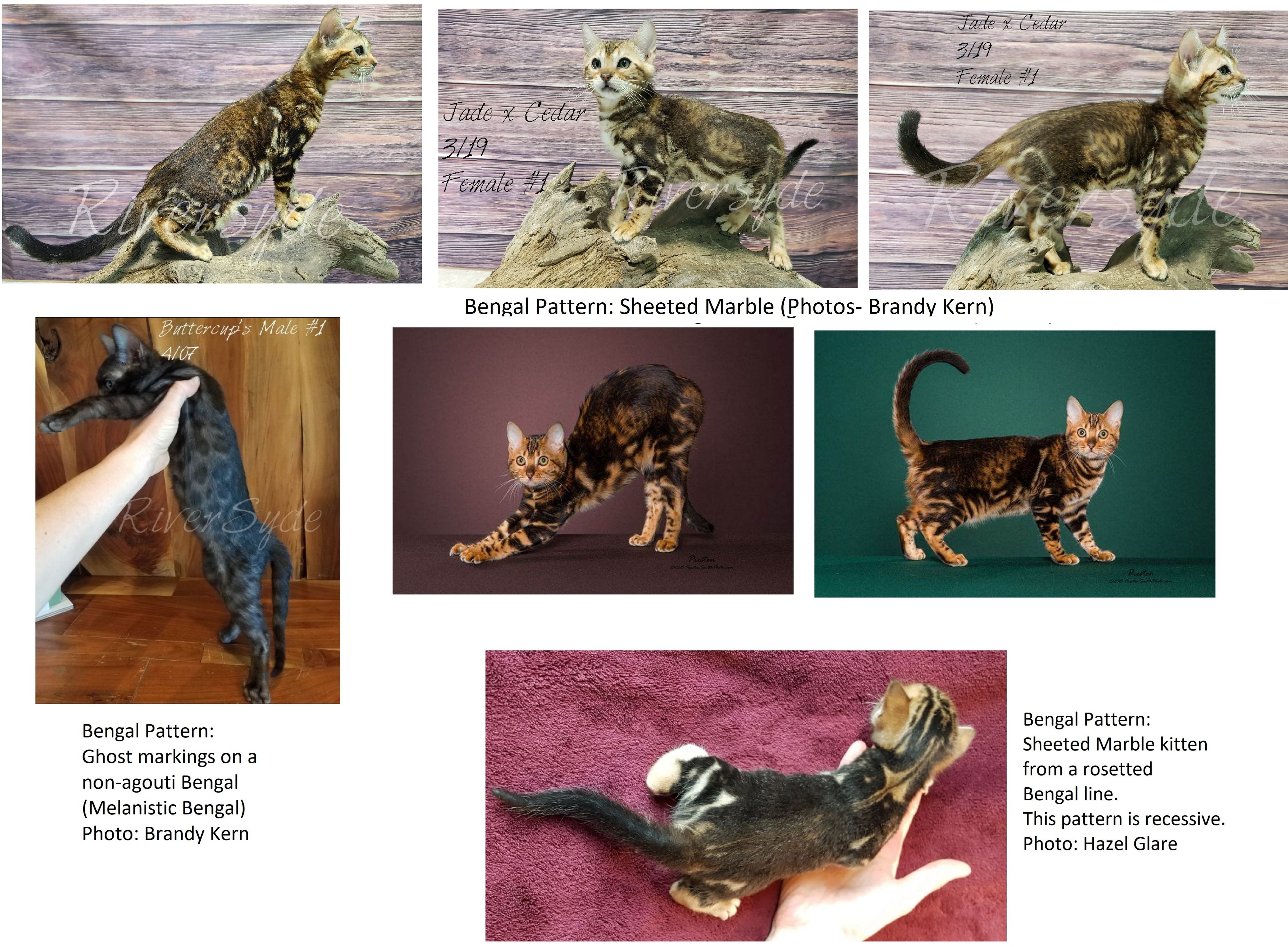
Charcoal Tabby
Charcoal is a modification of the tabby pattern, rather than a separate colour hence there are Charcoal Brown, Charcoal Silver and Charcoal Snow Bengals. Interaction of ALC and domestic cat genes produced this tone and pattern. The ground colour has very little or no reddish tone (rufousing) and is greyish or dark brown instead. The markings are black or nearly-black. The dorsal stripe is wider and there is a distinctive dark mask on the face and nose. Several small wildcats have a rufous morph and a greyish morph (local adaptations to different environments in their range) and this has emerged in the Bengal breed. It is probably most striking on the Snow Bengals. Charcoal originated in the Bengal breed through a gene found in the Asian Leopard cat. It has also been found in the Savannah cat, introduced there by the Bengal. It was particularly seen in early generation Bengals. Since then, it has escaped into the random-breeding gene pool, most likely from pet Bengals/Bengal-outcrosses that were not neutered.
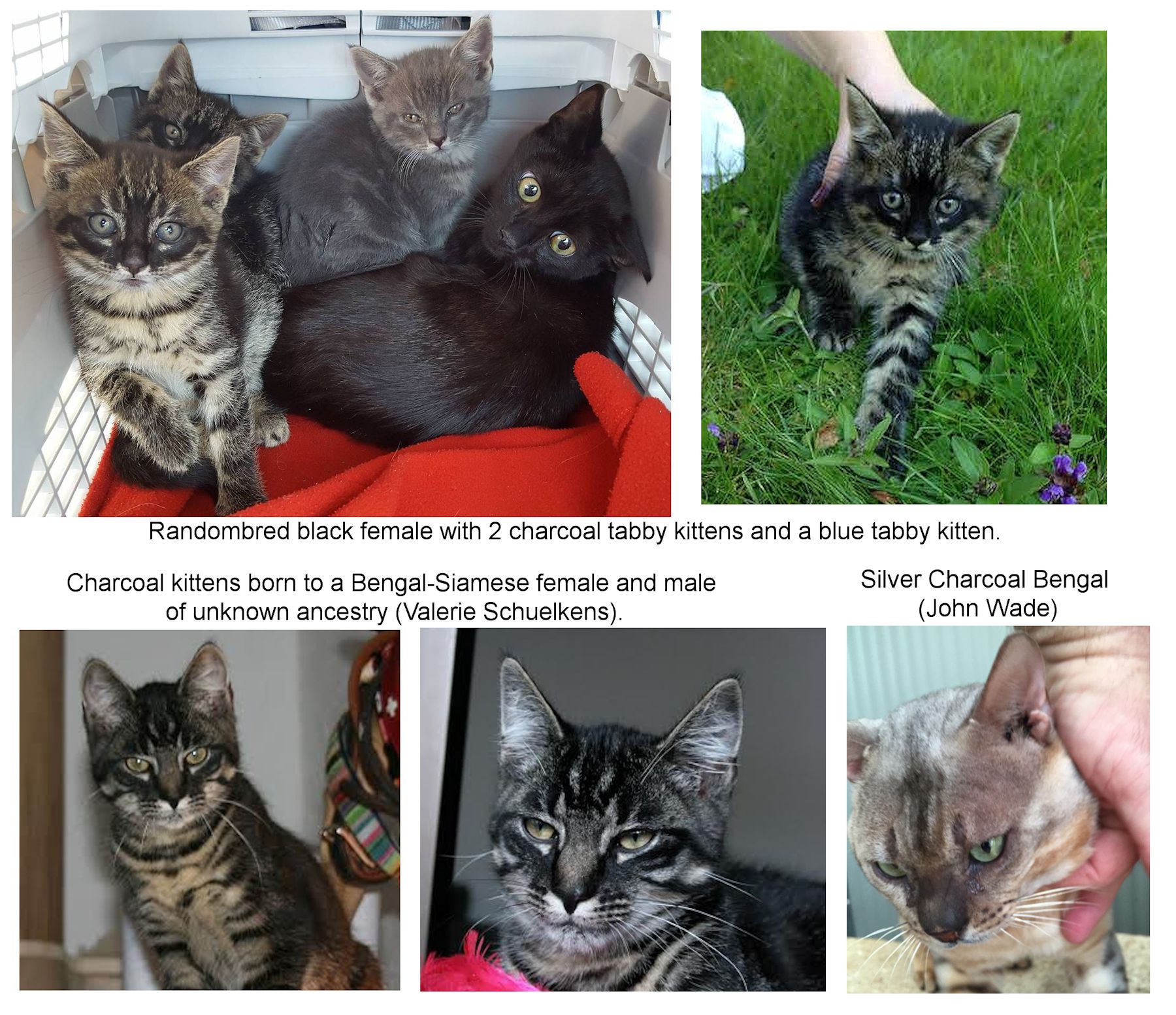
Joshua Dabbs and Terra Sinclair investigated the charcoal colour in Bengals. Charcoal is due to a variant in the agouti gene, known as "charcoal agouti." In the Bengal and Savannah, this wild variant gene interected with the domestic cat tabby genes to cause an increase in black pigmentation unevenly distributed throughout the coat. The distribution of pigmentation varies between cats. Early on in the Bengal breed history, charcoals were mis-identified as mink or smoke pattern or as Bengals with low levels of reddish pigment. Charcoal tabbies have "Zorro" markings with white goggles around the eyes and a dark "charcoal mask" from the forehead, down the nose-bridge and often underneath the eyes and extending into the mascara-lines; the mask resembles an upside-down "Y". Charcoals also have an unbroken "cape" or "sheet" down their backs. Charcoal can combine with silver tabby as well.
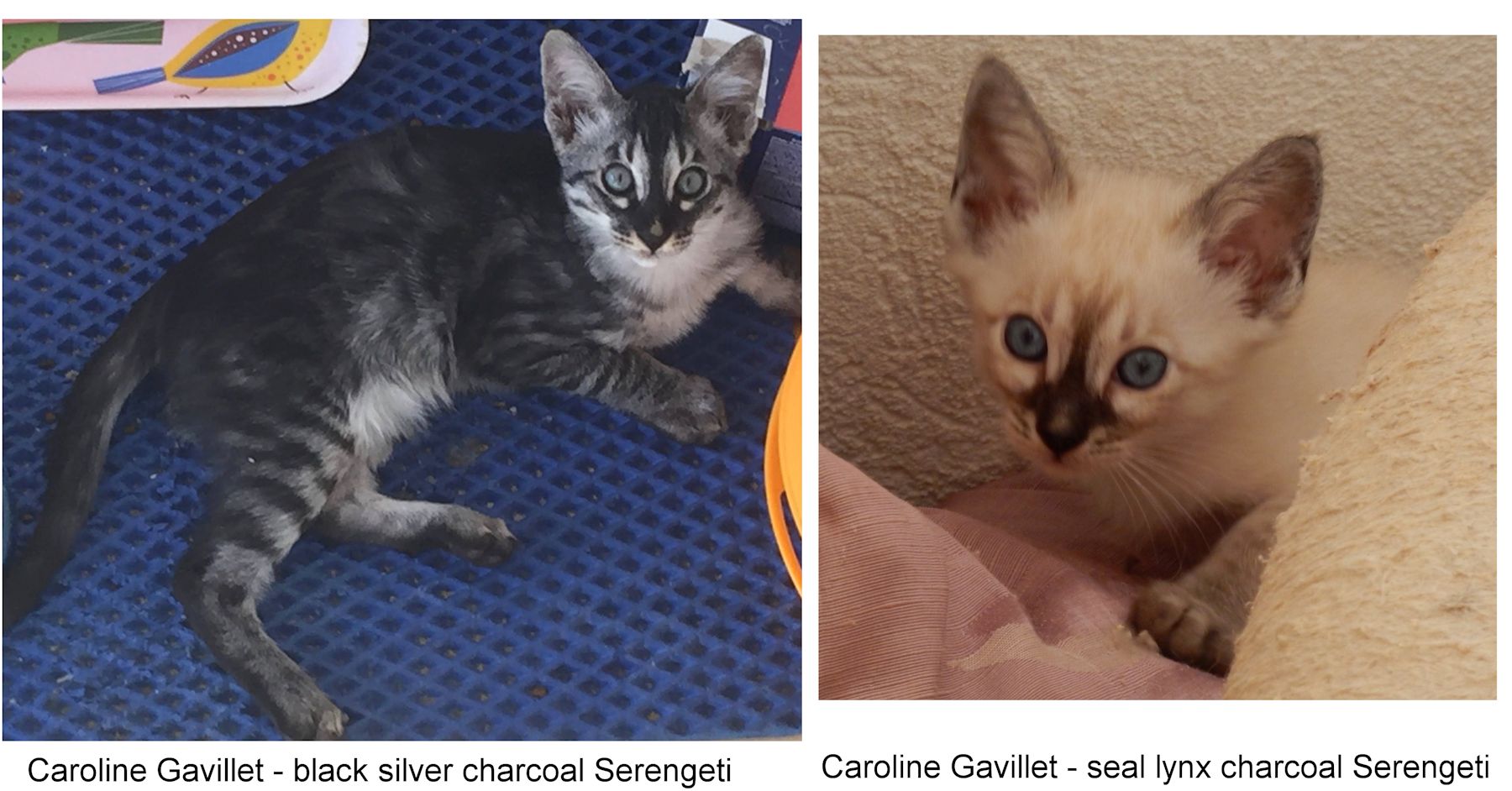
Over the years several cats with a "charcoal-like" pattern have appeared on Facebook cat genetics groups.

Asian Leopard Cat Agouti Gene
Charcoal is a form of partial melanism/abundism that darkens the back, giving the appearance of a black cape along the back and a zorro mask on the face. Approximately 5% of registered Bengal cats are charcoal. The candidate Agouti Signalling Protein (Asip) gene was previously associated with Charcoal in Bengal cats. Five out of 38 charcoal Bengals studied were homozygous for ALC Asip; 27 heterozygous for ALC-derived Asip allele + a domestic cat non-agouti allele (Asipa). Homozygous Asipa caused complete melanism (self black) in normally black-marked Bengals. [Note: in cats with other marking colours, homozygous Asipa causes the corresponding self colour).
Charcoal appears to be caused by reduced expression of a normal leopard cat Asip gene in a domestic cat background. There are 5 distinct ALC Asip haplotypes in the Bengal, each of which can cause charcoal. Each haplotype comes from an independent introgression event from a different ancestral leopard cat chromosome.
The charcoal phenotype has never been reported in the ALC, even if they are homozygous for the mutation. It is only when it interacts with domestic cate genes that the charcoal pattern appears.
- AsipPb - Asip from leopard cat - 4 different variants of AsipPb have been identified so far.
- AsipFc - Asip from domestic cat
- Asipa - domestic cat non-agouti gene (the "self colour" gene when homozygous)
- Melanocortin 1 receptor (Mc1r) encodes the receptor for Asip.
- AsipPb/Asipa (i.e. heterozygous) gave charcoal.
Researchers found that a Bengal with the ALC version of Mc1r had the same charcoal pattern as a sibling with the domestic cat version of Mc1r. The presence of absence of ALC-Mc1r did not affect the charcoal pattern. In heterozygous AsipFc/AsipPb cats there was reduced expression of the AsipPb allele, probably due to a mismatch between domestic cat transcription factors and ALC regulatory elements. Gene regulatory incompatibilities may contribute to selection against other ALC-derived genes in the Bengal cat genome.
Source: Christopher B. Kaelin, Kelly A. McGowan, Anthony D. Hutcherson, John M. Delay, Gregory S. Barsh, "Ancestry dynamics and trait selection in a designer cat breed," December 12, 2022,
The reason AsipPb/AsipPb cats canbe either charcoal or non-charcoal is probably due to which of the AsipPb mutations they have and how these interact with each other. These photos from Gina Stokes, Cositoes Bengal Cats, show that Bengals with 2 copies of the Asian Leopard Cat version of the agouti gene tend to have a deeper colour, with more contrast, than those that don't have 2 copies of this gene.
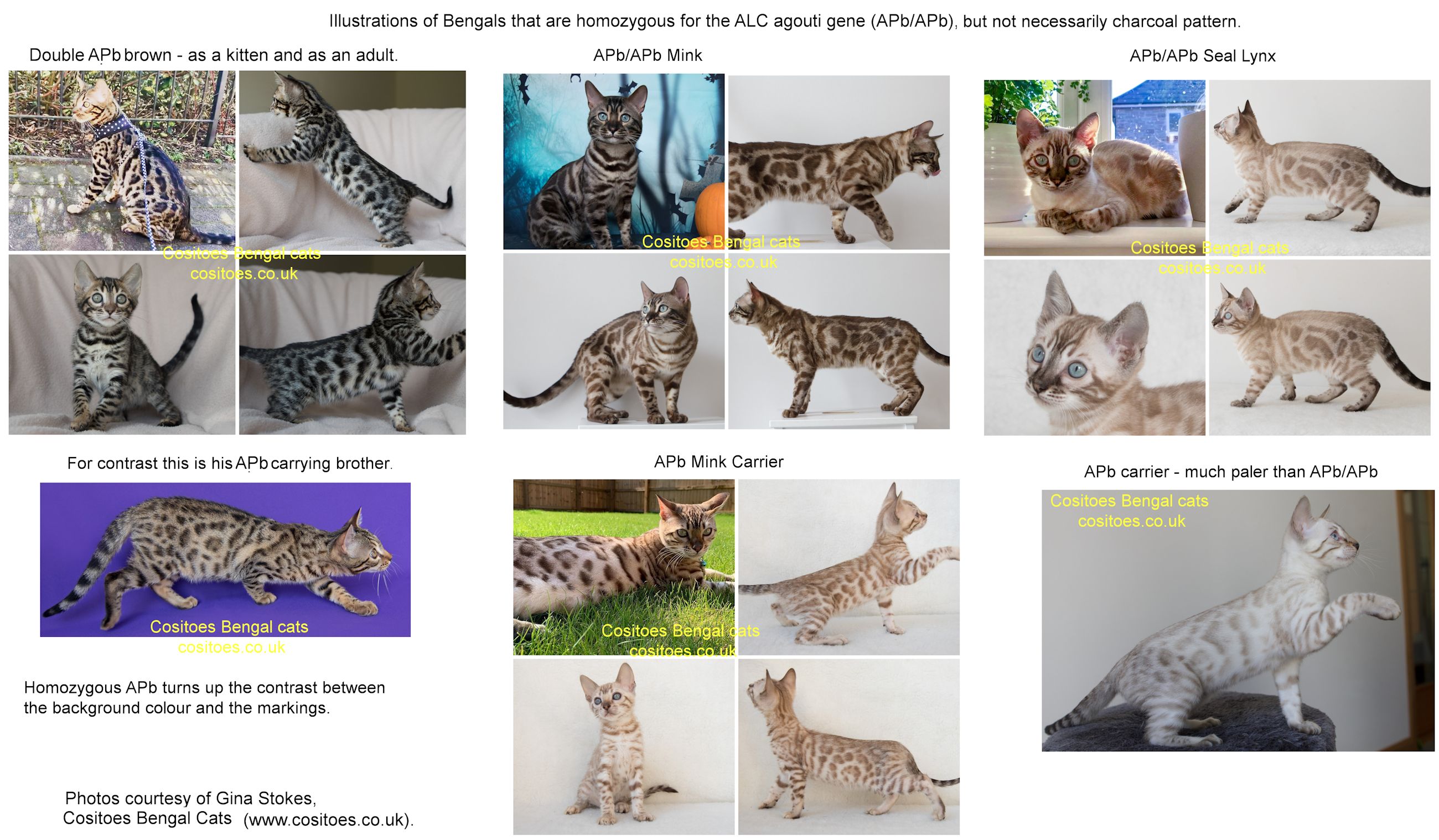
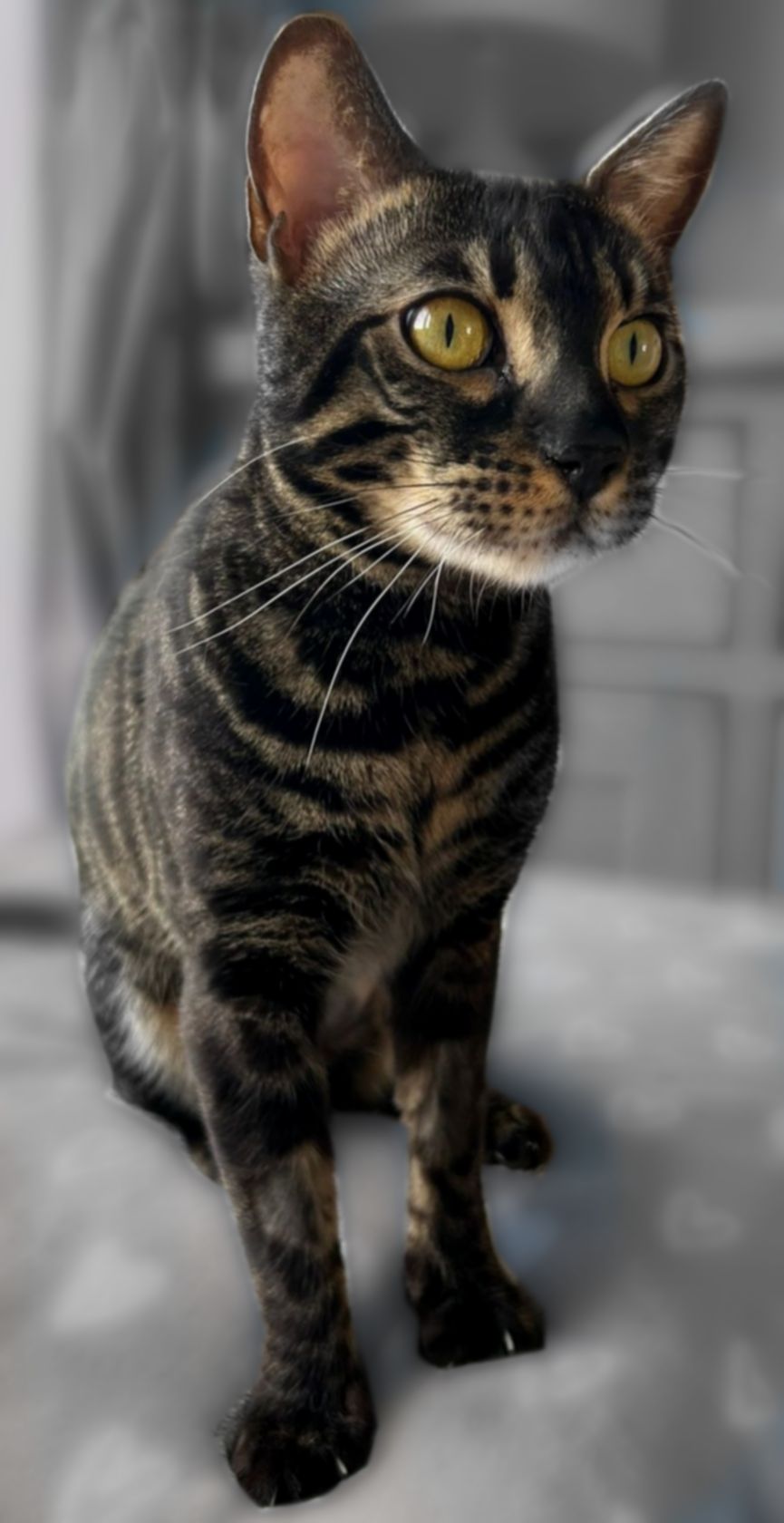
Summary of Ancestry dynamics and trait selection in a designer cat breed - Christopher B. Kaelin, Kelly A. McGowan, Anthony D. Hutcherson, Tosso Leeb, William J. Murphy, Gregory S. Barsh. Current Biology, March 25, 2024 [parts of this were previously released in December 12, 2022]
This is a brief, non-technical summary of the above paper. The researchers studied hundreds of Bengal cats to investigate the genetic origins of their leopard-like patterns. Incompatibility between domestic cat and Asian leopard cat (Prionailurus bengalensis) genes explains some popular colour traits. Selection for a hypomorphic allele of Fgfr2 explains glittered hair.
The researchers considered the unique-looking Bengals as an interesting way to study how genetic variation causes diversity in form, colour and pattern. In 2008, they began contacting Bengal breeders and owners to collect cheek swabs and photographs of Bengal cats. Gene sequencing of 947 Bengal cat genomes showed there were no parts of the wild Asian leopard cat (ALC) genomes that were found in all of the Bengal cats tested. Only 3.48% of the Bengal genome derives from the ALC, lower than the 6% predicted. The ALC genes were believed responsible for the unique marbled, rosetted and spotted patterns and glitter of Bengal cats, but this research found that not to be the case.
The ALC genes are scattered across 93% of the Bengal genome meaning they do not show up strongly as specific Bengal traits. Two Bengal traits - "charcoal" and "pheomelanin intensity" ("rufism") - are caused by ALC genes whose expression is reduced in a domestic cat background due to genetic incompatibilities in hybrids. The Bengal's genes for colour and pattern are mostly from the domestic cat. The glitter and leopard-like patterns come from domestic cat genes that were strongly selected for in the hybrids, although breeders believed they were selecting for ALC pattern genes.
About 60% of all Bengal cats have the "glitter" trait (particularly soft, iridescent fur). A mutation in the domestic cat Fgfr2 gene was found to be responsible for glitter. Glitter and the underlying Fgfr2 mutation are nearly specific to Bengal cats [note: other satin-coated breeds in development haven't been tested for Fgfr2 mutations, but their existence reinforces the domestic cat origin of "glitter"]. The Fgfr2 mutation reduces the activity of the protein encoded by Fgfr2, but does not inactivate it.As noted previously, "charcoal" Bengal are due to the ALC version of the Asip gene [AsipPb] being incompatible with the domestic cat genes. This mismatch causes the charcoal colour in the hybrids. In ALCs, AsipPb doesn't cause the charcoal pattern because there is no mismatch. Charcoal is also present in Savannah cats.
Tortoiseshell Bengals
Tortoiseshell Bengal. Although tortie Bengals appeared in the early generations bred by Jean Mill, they were not bred because the black-on-tawny pattern was closer to the wild ancestor. Now that the Bengal's distinctive pattern has been established, there is more interest in other colours including the tortie, look that Jean Mill described as a "jewelled cat." The interaction of ALC genes such as CORIN in a domestic cat genome adds to the vibrant colour.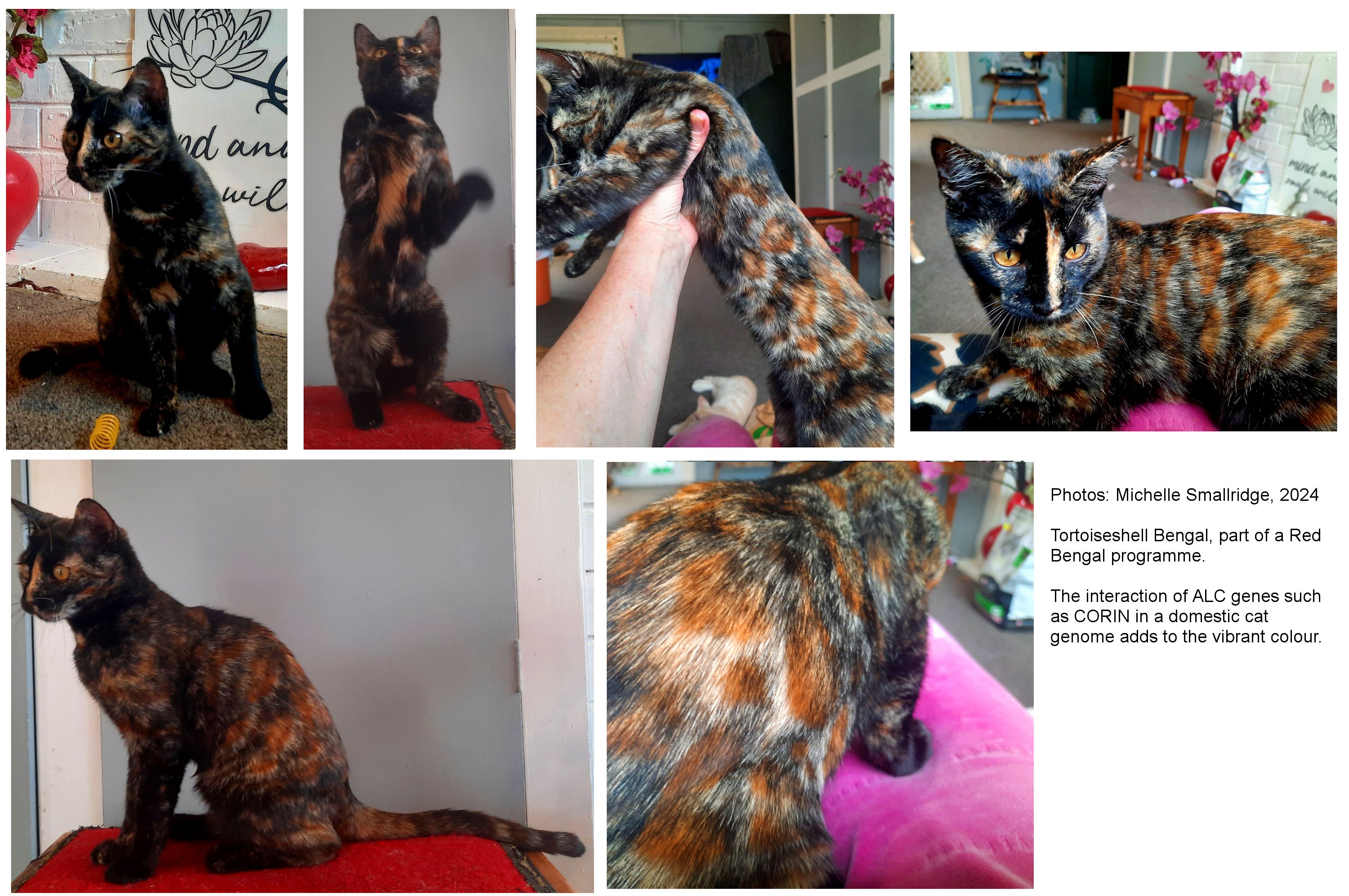
Although genetically solid, her underlying tabby pattern is Bengal rosetted spotting, which is expressed very strongly in the red markings (the non-agouti gene cannot completely suppress the tabby markings). In Bengals, the colour is very dense with very little ticking of the hairs (which would diffuse the tortie pattern in non-Bengals). The “too the roots” nature of the Bengal’s black colour makes the contrast even more vivid.
Sorrel, Wheaten and Whited
Sorrel is a colour variety of the Bengal in which the body pattern markings are lighter shades of brown. Leg and tail markings can be darker. Some Sorrel Bengals have a rufous (orange-hued) appearance. Non-rufoused Sorrels are known as Wheaten Sorrel because of their very light ground colour. Sorrel Bengals often has the Asian Leopard Cat's "whited" expression. Cinnamon arrived on the scene as a recessive gene from domestic outcrosses. The Sorrel Bengal's striking red colour resembles non-sex-linked red (cinnamon) in Abyssinians. In Bengals, this cannot not be the sex-linked orange gene as this was eliminated early on from mainstream breeding programmes (there are now a red and tortie Bengal breeding programmes). Testing ruled out the extension (amber) gene and sorrel appears to be analogous to cinnamon, a recessive allele of black. Whited sorrels, had white fronts and undersides reminiscent of golden tabby tigers, but they don't carry any white spotting genes - it is due to a more visible expression of the ALC pattern. Some sorrels were a bright reddish colour due to the Bengal CORIN gene, but wheaten sorrels also occur. Naturally sorrel combines with colourpoint and mink patterns. The bright red-on-golden sorrels are distinctive and attractive enough that some breeders are championing them.
|
|
|
"Whited" refers to the white colour on the belly, central line of the chest and the face. This is not a tuxedo pattern, but comes from the Asian Leopard Cat and is desirable, particularly in the Sorrels.
Bengal Sorrel - CORIN Gene
The researchers disregarded known Mendelian colours - colourpoint, dilute, and silver - and focussed on the variation ranging from grey-brown to red-orange. Asip and Corin genes act on the same genetic pathway to regulate the type (black/brown eumelanin or red/yellow pheomelanin (Asip) and amount of pigment produced in hair follicles (Corin).
Corin encodes a Type 2 transmembrane serine protease that is co-expressed with and acts downstream of Asip. Corin loss-of-function mutations, including missense mutations in domestic cats and the tiger, are responsible for autosomal recessive forms of golden coat colour. In Bengal cats, AsipPb and CorinPb allele frequencies correlate with colour variation, but in opposite directions. Asian Leopard Cat (ALC)-Asip allele frequencies decrease and ALC-Corin allele frequencies increase as coat colour changes from grey-brown to red-orange tones across individuals. ALC introgression is associated with loss-of-function effects at multiple loci, and the combined effect contributes to this diversity.
The researchers found a number of single nucleotide variations in the Bengal corin gene. They found 19 protein-altering Corin variants in Bengal cats. 7 are not associated with colour variation. A corin allele of domestic cat origin also contributed to colour variation in Bengals.
None of the three Corin loss-of-function coding mutations responsible for recessively inherited light/amber cat colour in other breeds were detected.
CORIN:C.839G>A - extreme-sunshine Siberian cats.
CORIN:C.2383C>T - sunshine Siberian cats.
CORIN:C.2425C>T - copper/flaxen gold/akita British Shorthair/Longhair cats.
CORIN:C.1759C>T - golden tiger.
This means there are novel Corin mutations in Bengals referred to here as CorinPb. A distinct Corin allele from domestic cat ancestors contributes to colour variation in Bengal cats.
f the 19 protein-altering Corin variants in Bengal cats, 7 did not cause colour variation. 10 were polymorphic between leopard cats and domestic cats but were not polymorphic within domestic cats. The remaining 2 were located outside the peak interval of association, suggesting that a domestic cat single nucleotide variations affecting colour diversity probably acts as a regulator.
None of the three domestic cat Corin mutations were detected in Bengal cats. This means there are novel Corin mutations in Bengals referred to here as CorinPb.
- Christopher B. Kaelin, Kelly A. McGowan, Anthony D. Hutcherson, John M. Delay, Gregory S. Barsh, "Ancestry dynamics and trait selection in a designer cat breed," December 12, 2022.
Glitter
Glitter appears to be an autosomal recessive trait.
About 60% of all Bengal cats have the "glitter" trait (particularly soft, iridescent fur). A mutation in the domestic cat Fgfr2 gene (Fibroblast growth receptor 2) was found to be responsible for glitter. Glitter and the underlying Fgfr2 mutation are nearly specific to Bengal cats [note: other satin-coated breeds in development haven't been tested for Fgfr2 mutations, but their existence reinforces the domestic cat origin of "glitter"]. The Fgfr2 mutation reduces the activity of the protein encoded by Fgfr2, but does not inactivate it.
There is strong evidence that Glitter is a hypomorphic mutation of Fgfr2 and the researchers called the two alleles as Fgfr2gl and Fgfr2+.
For all four types of hair (guard, awn, down, and awn-down), the width of the medulla in Fgfr2gl/gl hair is significantly reduced compared to Fgfr2gl+ or Fgfr2+/+ hair. Reduced medullary width is also associated with a similar trait called Satin in mice and rats (different genes are involved in each). Reduced medullary width may explain differences in hair texture but was unlikely to account for the characteristic Glitter/Satin appearance. There was an additional abnormality in down hairs, which account for 75% of the coat. Normally, the hair medulla contains a vertical array of keratinocytes that alternate with air cells. In down hairs this array becomes thin and fragmented towards the tip of the hair. In Fgfr2gl/+ or Fgfr2+/+ hair, the gap between the thin, fragmented portion of the medulla begins ~1mM from the tip, but in Fgfr2gl/gl hairs, that gap is 3 – 4 times larger. This is probably why glitter coats have a translucent and iridescent appearance.
Researchers concluded that Glitter is caused by reduced expression of Fgfr2 that leads to changes in hair thickness and structure without affecting hair structure or function.
Melanistic, Blue and Albino
Melanistic is a Black Self Bengal due to the recessive non-agouti gene inherited from domestic cats. In bright sunlight, the coat pattern can be discerned. These cats resemble black panthers.
Blue has a cream-to-pale-peach-to-pale-grey ground colour and darker grey-blue markings. because the colour has never been observed in Asian Leopard Cats, it is not recognised in the Bengal breed. Some breeders began working with the colour since the Bengal personality, type and patterns were established enough and distinctive enough that a Blue Bengal would not be "just another tabby cat."
Albino is pure white with reddish-to-lilac eyes and pink paw-pads. This gene appears to have come from the Asian Leopard Cat as it has been observed in the wild.
Alongside the patterns there are some fur effects such as glitter (a satiny sparkle on the coats due to hollow spaces in the hairs); patina (where dark hairs blur the basic black contour and brown pattern on the back and shoulders giving the impression fading) and ticked pattern (where randomly appearing darker and lighter stripes on the hairs mean the pattern is overlaid on a wild-looking ticked background colour, especially on the back and sides).
Thanks to the persistence of recessive genes, semi-longhaired Bengals turned up periodically. The recessive the gene wasn't going to go away and the cats were attractive so they were developed into the Cashmere (aka Pardino) which is identical in all other respects to the Bengal.
|
|
|
.. and onto the Savannahs.
Bengals have been used in Savannah breeding programmes so it's unsurprising that similar variants have already turned up. Charcoal and sorrel Savannahs have already appeared. The original Savannahs were tawny/sandy with black spots, but these were quickly joined by the silver Savannahs whose black spots contrast spectacularly with the pale silvery background.
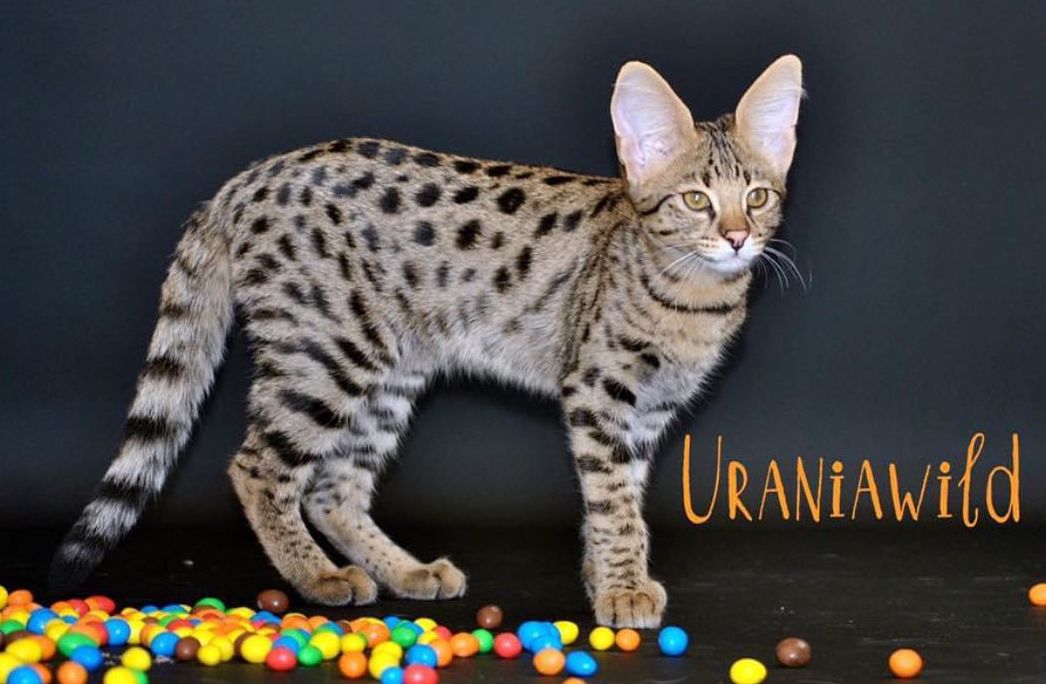
Snow Savannahs, have been bred using colourpoints; they are attractive and they mimic the albino serval (which is creamy white with pale lilac or fawn markings), but they have not yet been accepted by any major association. Melanistic Savannahs also turn up due to the recessive non-agouti gene.
The Savannah will no doubt have its own mixed bag of recessives inherited from domestic foundation stock so other variations will crop up in later generations. One that has already appeared is the servaline pattern where the cats are freckled with small spots instead of marked with distinct large spots. This pattern occurs naturally in the serval and is seen from time to time in speckled domestic cats when the spotted tabby gene interacts with the ticked/agouti gene. Marbled and charcoal patterns also occur.
Uraniawild Cattery is working with red Savannahs (which means tortoiseshell Savannahs also occur) and with the servaline ticked pattern and the marble pattern. In addition, a dominant blue eye (DBE) gene has been introduced into a breeding line (from Topaz and DBE Maine Coon outcrosses). The red Savannahs have a similar look to the rare red-spotted cheetah and red-spotted leopard that have been reported from Africa, while the marble pattern brings to mind the dark swirled pattern of the king cheetah. Uraniawild Cattery
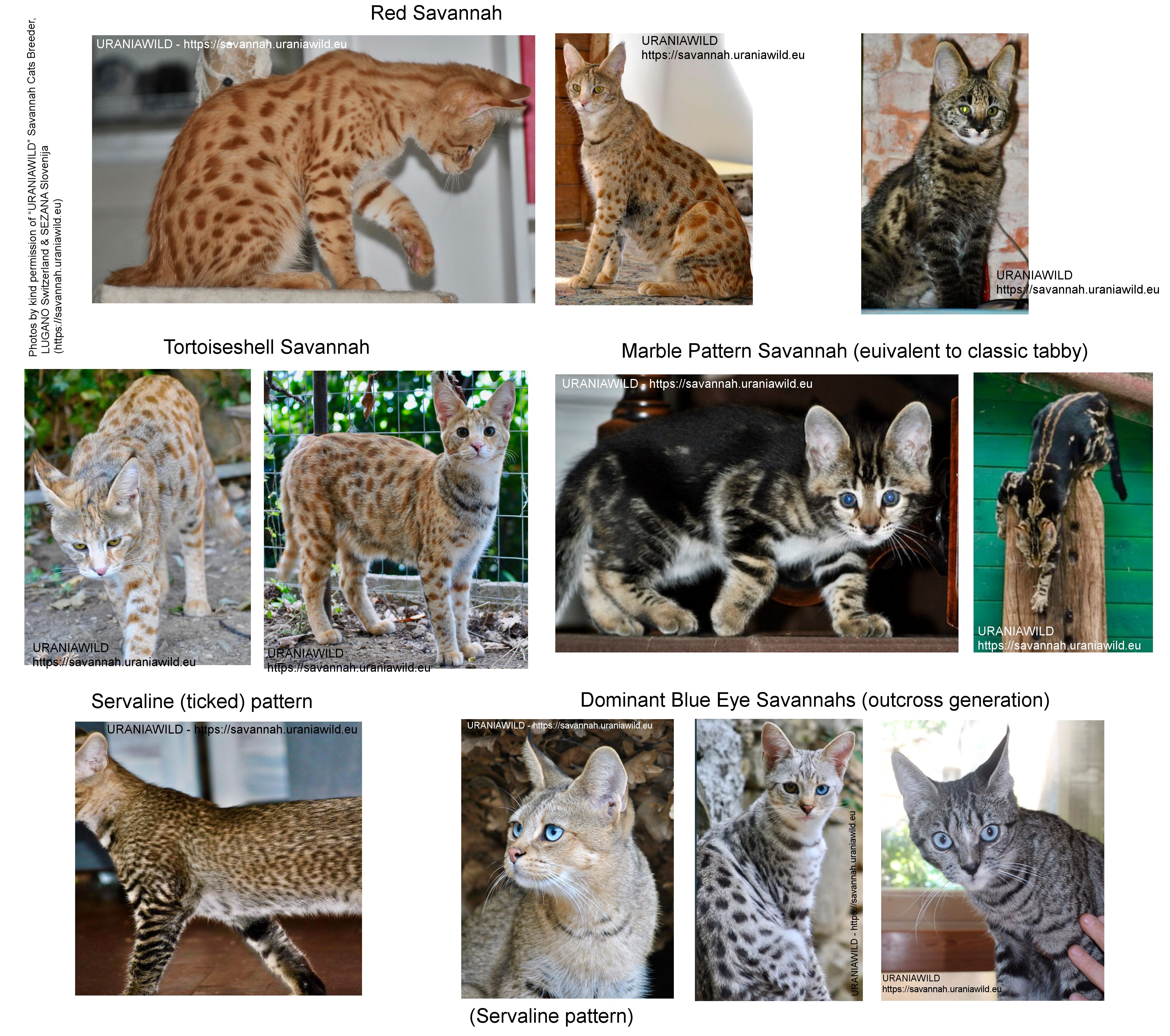
Another surprise in the Savannah was the appearance of a rexed Savannah - something curly was evidently lurking in one of the non-pedigree outcross domestic cats used by breeders who didn't want to risk the life of an expensive pedigree queen with a male Serval.
Spotted Survivors
With the addition of the Egyptian Mau, Ocicat, Serengeti (not much has been heard about them of late), Cheetoh and various spotted tabbies, the cat fancy has probably reached saturation point with spotted breeds. Many of the newer experimental breeds will probably prove to be not distinct enough from recognised breeds to be a long-term proposition.
How many more wild cats can be bred to domestics to create something visibly different from the Bengal or Savannah? Some, such as Geoffroy's Cat hybrids and Oncilla hybrids ran into fertility problems. Another problem is that many spotted cat hybrids, such as margay or ocelot hybrids tend to resemble early generation Bengals anyway. Bengals and Savannahs have already cornered the market when it comes to wild-looking spotted domestics. Other "wild" colours and patterns would need to come from elsewhere in this never-ending quest for novelty.
Ploughing their own furrows, the Chausie, the Caracat ....
Meanwhile, other breeders have been working with Jungle Cat hybrids to create the Chausie and the puma-coloured Stone Cougar (the latter not being recognised by mainstream registries). Rather than having spotted coats, these have ticked colouration. The Jungle Cat brought with it another selection of colour genes though its breed progress has been slower than that of the spotted hybrids. As well as the brown ticked tabby Chausie, there are melanistic and grizzled tabby Chausies whose colours are due to their wild cat genes. Chausie breeders have stuck to those 3 colours which are found in the wild Jungle Cat. Chausies are already being crossed with other breeds, so who knows what will happen when the grizzle pattern interacts with domestic cat colour genes! Chocolate, cinnamon or blue grizzle might be on the cards.
The recently developed Caracat aims to mimic the form and colour of the Caracal, especially the spectacular black ear tassels. The Caracat has a brown ticked colour, though by using different outcrosses, these hybrids could potentially mimic the Caracal-Serval hybrids that are produced as exotic pets.
... and the Marguerite ...
Even more recent is the Sand Cat hybrid or Marguerite. Sand Cats have grey markings on a sandy background. The first generation of hybrids had a sandy base colour and either pale grey spotting or grey ticking which is heaviest along the back. It may be a challenge to preserve these patterns and not introduce too many domestic cat colours or markings into the mix. Breeders select outcrosses to maintain the colour and conformation of the Sand Cat in the hybrids. If the breed develops, no doubt others will experiment by mixing Marguerites with other domestic cats to see how the colours interact.
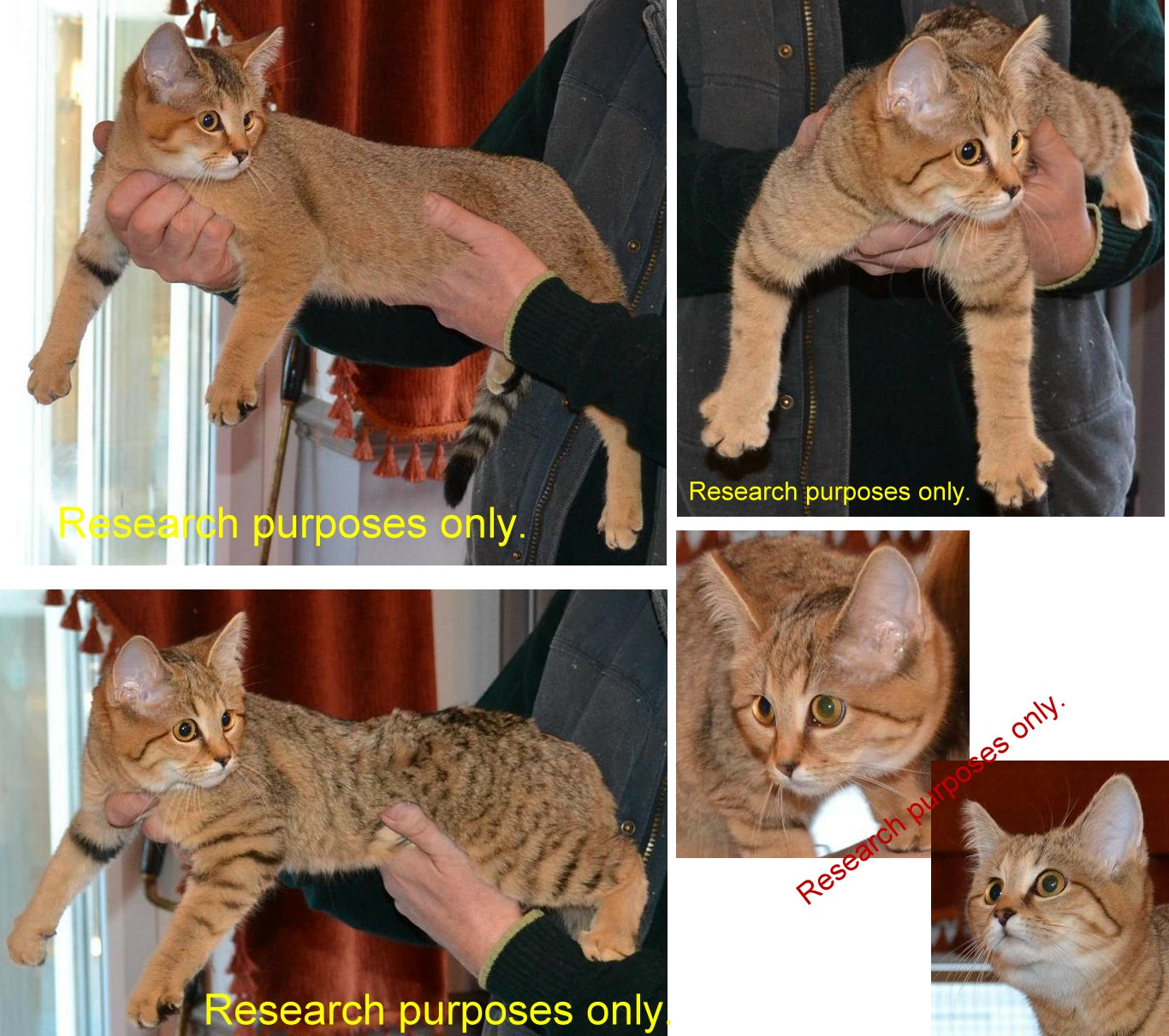
... but no-one for rusty spots?
Although Rusty-Spotted Cats naturally hybridise with domestics near villages, currently no-one seems interested in working with these hybrids. The reddish horizontally aligned spotted markings on a greyish background colour would be an interesting addition to the existing palette. Rusty-Spotted Cats are also apparently tameable, another factor that makes hybrids a feasible proposition.
Lions and Tigers
Instead of breeding ocelot- and leopard-lookalikes, some breeders have moved towards tiger-lookalikes. The Toyger, a striped cousin of the Bengal, is currently bred to be tawny/orange with a pale belly and deep black stripes. The tiger also occurs in black-on-white, brown-on-white, stripeless white, golden tabby (dark gold stripes on a golden background with white belly, chest and chin) and even black-on-blue-grey so maybe there will also be Snow Toygers, Sorrel Toygers and Blue Toygers sometime in the future.
Although maned cats have occurred, for example Ugly Bat Boy who was nude apart from his luxuriant mane, true lion-lookalikes haven't yet arrived. It's not a wild hybrid, but the mutation is already in the gene pool and just needs to be fixed as a breed trait.